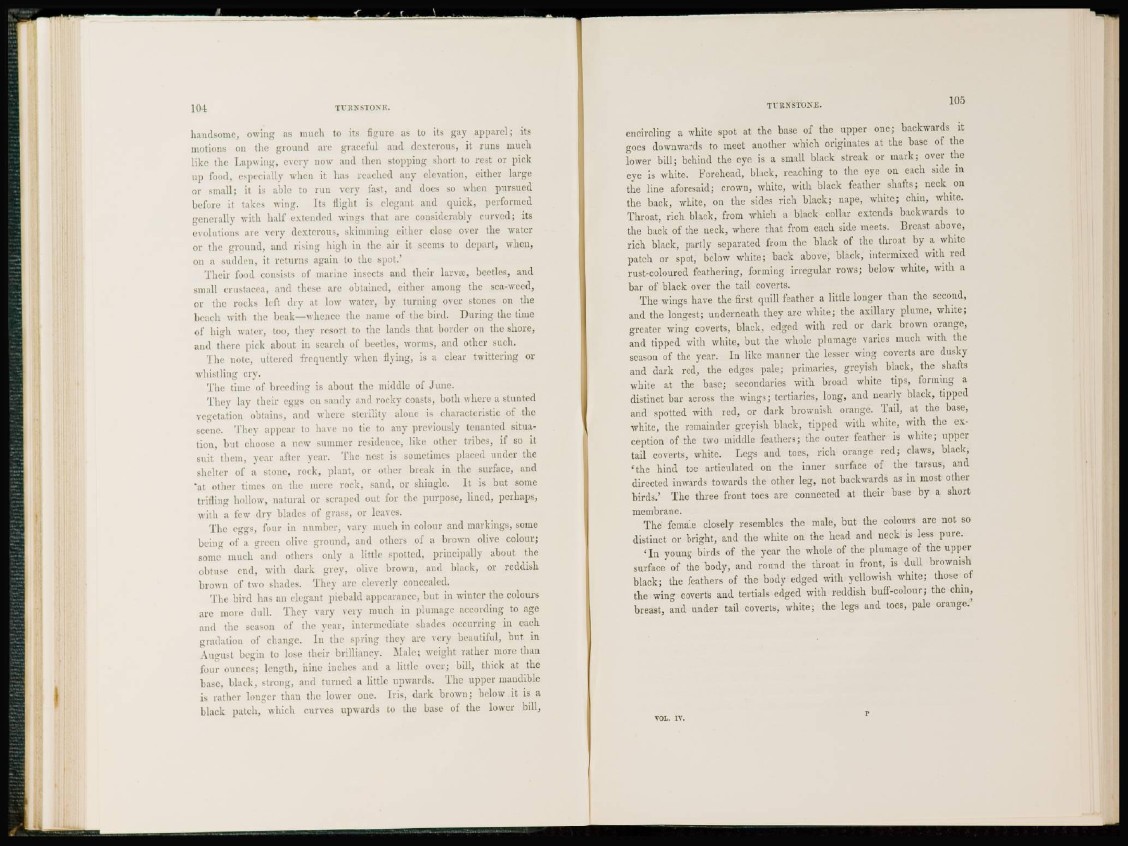
104 TURNSTONE.
handsome, owing as much to its figure as to its gay apparel; its
motion* on the ground arc graceful and dexterous, it runs much
like the Lapwing, every now and then stopping short to rest or pick
up fund, especially when it has readied any elevation, either large
or small; it is able to run very fast, and does so when pursued
before it takes wing. Its flight is elegant and quick, performed
generally with half extended wings that are considerably curved; its
evolutions are very dexterous, skimming either close over the water
or the ground, and rising high in the air it seems to depart, when,
on a sudden, it returns again to the spot.'
Their food consists of marine insects and their larvae, beetles, and
small Crustacea, and these arc obtained, either among the sea-weed,
or the rocks left dry at low water, by turning over stones on the
beach with the beak—whence the name of the bird. During the time
of high water, too, they resort to the lauds that border on the shore,
and there pick about in search of beetles, worms, and other such.
'1 he note, uttered frequently when flying, is a clear twittering or
whistling cry.
The time of breeding is about the middle of June.
They lay their eggs on sandy and rocky coasts, both where a stunted
vegetation obtains, and where sterility alone is characteristic of the
scene. They appear to have no tie to any previously tenanted situation,
but choose a new summer residence, like oilier tribes, if so it
suit them, year after year. The nest is sometimes placed under the
shelter of a stone, rock, plant, or other break in the surface, and
*at other times on the mere rock, sand, or shingle. It is but some
trifling hollow, natural or scraped out for the purpose, lined, perhaps,
with a few dry blades of grass, or leaves.
The eggs, four in number, vary much in colour and markings, some
being of a green olive ground, and others of a brown olive colour;
some much and others only a little spotted, principally about the
obtuse end, with dark grey, olive brown, and black, or reddish
brown of two shades. They are cleverly concealed.
The bird has an elegant piebald appearance, but in winter the colours
are more dull. They vary very much in plumage according to age
and the season of the year, intermediate shades occurring in each
gradation of change. In the spring they arc very beautiful, but in
August begin to lose their brilliancy. Male; weight rather more than
four ounces; length, nine inches and a little over; bill, thick at the
base, black, strong, and turned a little upwards. The upper mandible
is rather longer than the lower one. Iris, dark brown; below it is a
black patch, which curves upwards to the base of the lower bill,
TTRXSTONL'.
encircling a white spot at the base of the upper one; backwards it
goes downwards to meet another which originates at the base of the
lower bill; behind the eye Ís a small black streak or mark; over the
eye is white. Forehead, black, reaching to the eye on each side in
the line aforesaid; crowu, white, with black feather shafts; neck on
the back, white, on the sides rich black; nape, white; chin, white.
Throat, rich black, from which a black collar extends backwards to
the back of the neck, where that from each side meets. Breast above,
rich black, partly separated from the black of the throat by a white
patch or spot, below white; back above, black, intermixed with red
rust-coloured feathering, forming irregular rows; below white, with a
bar of black over the tail coverts.
The wings have the first quill feather a little longer than the second,
and the longest; underneath they are white; the axillary plume, white;
greater wing coverts, black, edged with red or dark brown orange,
and tipped with white, but the whole plumage varies much with the
season of the year. In like manner the lesser wing coverts are dusky
and dark red, the edges pale; primaries, greyish black, the shafts
white at the base; secondaries with broad white tips, forming a
distinct bar across the wings; tertiaries, long, and nearly black, tipped
and spotted with red, or dark brownish orange. Tail, at the base,
white, the remainder greyish black, tipped with white, with the exception
of the two middle feathers; the outer feather is white; upper
tail coverts, white. Legs and toes, rich orange red; claws, black,
( t h e hind toe articulated on the inner surface of the tarsus, and
directed inwards towards the other leg, not backwards as in most other
birds.' The three front toes are connected at their base by a short
membrane.
The female closely resembles the male, but the colours are not so
distinct or bright, and the white on the head and neck is less pure.
' I n young birds of the year the whole of the plumage of the upper
surface of the body, and round the throat in front, is dull brownish
black; the feathers of the body edged with yellowish white; those of
the wing coverts and tertials edged with reddish buff-colour; the chin,
breast, and under tail coverts, white; the legs and toes, pale orange.'
r